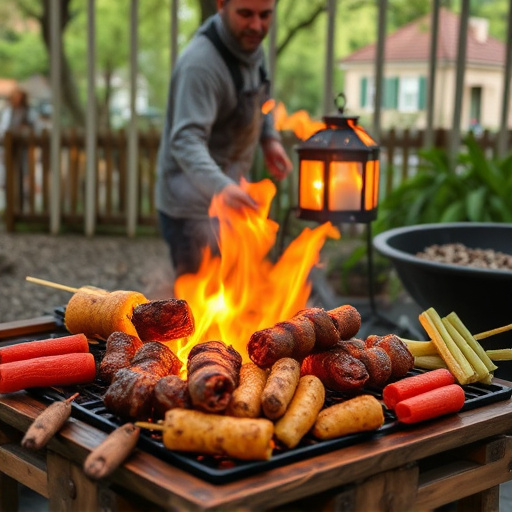Selecting high-quality cuts of baby back or spare ribs is crucial for a great BBQ rib recipe, along with creating a dry rub blend and mastering low and slow cooking techniques. The science behind collagen breakdown ensures tender meat, while sauces and glazes add flavor. Grilling vs smoking offers contrasting approaches, and creative side dishes enhance the overall experience.
Unleash the aroma of perfectly cooked BBQ ribs and prepare for a culinary journey! This ultimate guide unveils classic techniques to craft mouthwatering ribs. From selecting the ideal cut of meat to mastering smoking techniques, we break down every step. Learn the science behind collagen breakdown for tender, juicy results. Discover diverse seasoning blends and saucy glazes to elevate your BBQ rib recipe. Whether grilling or smoking, this article equips you with the knowledge to become a true BBQ master.
- Selecting the Right Ribs: Choosing Quality Meat for Your BBQ Rib Recipe
- Dry Rub Basics: Crafting the Perfect Seasoning Blend for Flavorful Ribs
- Smoking 101: Mastering the Art of Low and Slow Cooking for Tender Ribs
- The Science Behind Collagen Breakdown: Understanding Why Patience is Key
- Sauces and Glazes: Adding Flavor and Shine to Your BBQ Ribs
- Grilling vs. Smoking: Choosing the Right Method for Your Desired Results
- Tips and Tricks for Serving and Pairing: Making Your Ribs the Centerpiece of Any Meal
Selecting the Right Ribs: Choosing Quality Meat for Your BBQ Rib Recipe
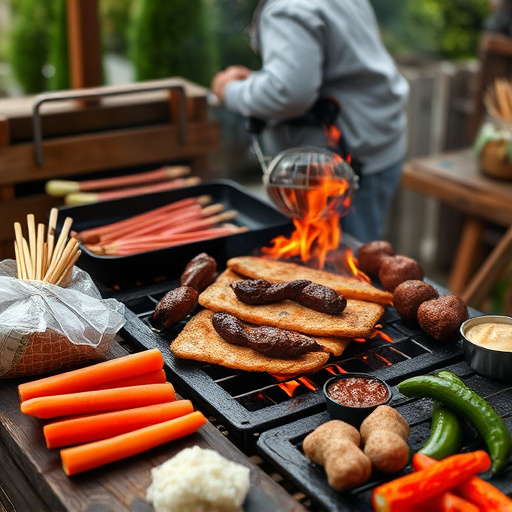
When it comes to crafting the perfect BBQ rib recipe, selecting the right ribs is a crucial first step. Opt for high-quality, meaty ribs with a good balance of bone and flesh. Look for ribs that are marbled with fat, as this adds flavor and moisture during cooking. Avoid overly lean cuts, as they can become dry and tough when grilled. Ribs that are at least 1/2 inch thick in the meat section will ensure even cooking and tender results.
Choosing the right rib cut is key to a successful BBQ rib recipe. Baby back ribs, for example, are a popular choice due to their smaller size, abundant marbling, and relatively uniform shape. Strips of spare ribs can also work well, offering a heartier, more substantial option. Regardless of the specific cut, selecting ribs from reputable sources that guarantee fresh, high-quality meat is essential for achieving mouthwatering, tender BBQ ribs that will satisfy any palate.
Dry Rub Basics: Crafting the Perfect Seasoning Blend for Flavorful Ribs
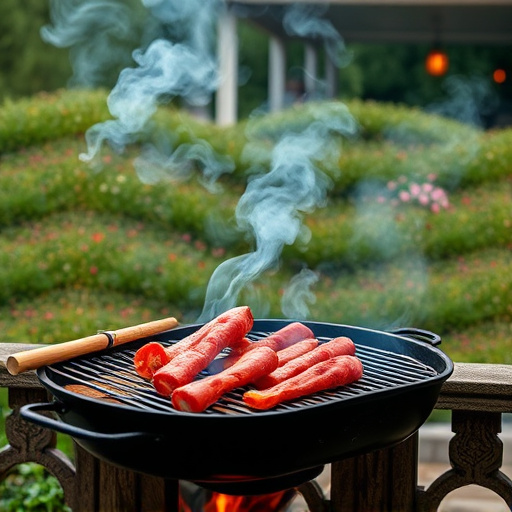
Crafting a dry rub is an essential step in preparing mouthwatering BBQ ribs. This simple seasoning blend adds layers of flavor that penetrate deep into the meat, making each bite explosive with taste. To create your own dry rub, start by combining a base of coarse sea salt and freshly ground black pepper, which form the backbone of any good rib rub. Next, add spices like paprika (smoked or sweet), garlic powder, onion powder, cayenne pepper, and mustard powder. Adjust the ratios based on your preferred heat level and flavor profile; a classic ratio is 2 parts salt/pepper, 1 part each of paprika, garlic, onion, and cayenne, with a pinch of mustard powder. Experiment with different spices to find your perfect blend, but remember, less is often more when it comes to dry rubs—too many spices can overpower the ribs’ natural flavor.
When crafting a BBQ rib recipe using a dry rub, apply a generous amount of the seasoning all over the ribs, both sides and ends. Let them sit for an hour or two at room temperature to allow the flavors to meld, or even overnight in the fridge for maximum infusion. This step ensures that your ribs are packed with flavor from the get-go, setting the stage for a truly exceptional BBQ experience.
Smoking 101: Mastering the Art of Low and Slow Cooking for Tender Ribs
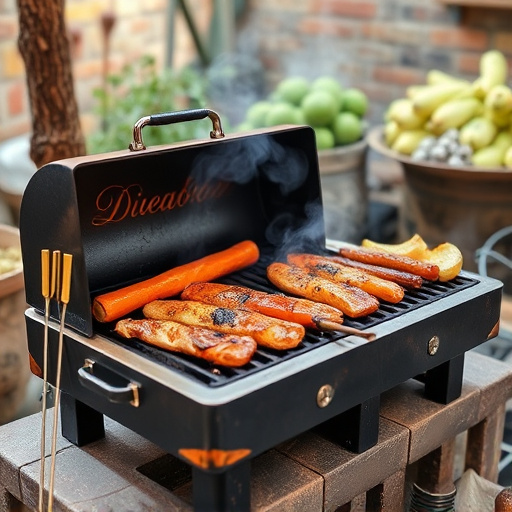
Smoking 101: Mastering the Art of Low and Slow Cooking for Tender Ribs
When it comes to grilling BBQ rib recipes, smoking is a classic technique that transforms tough cuts of meat into melt-in-your-mouth delights. The secret lies in embracing low and slow cooking—a method that requires patience but yields exceptionally tender ribs. By slowly cooking the ribs at lower temperatures, the collagen in the meat breaks down, resulting in a succulent, juicy finish. This process is often achieved using a smoker, which maintains consistent heat and humidity, ensuring even cooking.
Whether you’re an experienced griller or just starting, understanding this fundamental BBQ technique will elevate your rib recipes. It’s all about creating the perfect environment for slow transformation. With the right equipment and a bit of practice, you’ll soon become a master at smoking ribs, delivering mouthwatering results that your taste buds (and friends and family) will adore.
The Science Behind Collagen Breakdown: Understanding Why Patience is Key
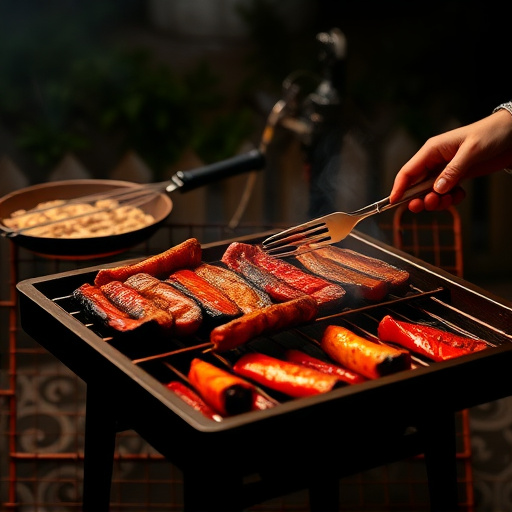
The art of barbecue involves more than just heating meat over fire; it’s a science, particularly when it comes to ribs. The key to perfect BBQ ribs lies in understanding the collagen breakdown process. Collagen is a protein that provides structure and strength to animal tissue, especially in bones and connective tissues found in ribs. When cooking ribs at low and consistent temperatures, the collagen slowly breaks down, transforming into gelatin. This transformation occurs between 170°F-205°F (77°C-96°C) and is crucial for achieving tender, juicy ribs.
Patience is essential here because rushing the process can result in tough, rubbery ribs. Slow cooking allows the collagen to break down evenly throughout the meat, ensuring a melt-in-your-mouth texture. This science-backed approach is what makes BBQ rib recipes so successful—a delicate balance of time, temperature, and moisture that results in a mouthwatering dish.
Sauces and Glazes: Adding Flavor and Shine to Your BBQ Ribs
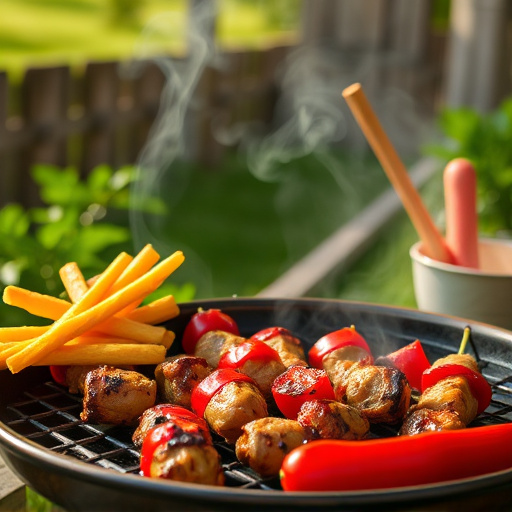
Sauces and glazes are essential components in elevating your BBQ rib recipe from good to great. They add a layer of flavor that penetrates deep into the meat, enhancing its natural taste and tenderness. More than just flavor, sauces also serve as a finishing touch, giving your ribs a glossy shine that’s visually appealing.
When selecting or creating your sauce, consider balancing sweet, tangy, smoky, and savory notes. A classic BBQ glaze might incorporate ingredients like brown sugar, ketchup, vinegar, garlic, and spices. Experimentation is key; adjust the recipe based on your preference for heat, acidity, or sweetness. The perfect sauce can transform a simple BBQ rib dish into an unforgettable culinary experience.
Grilling vs. Smoking: Choosing the Right Method for Your Desired Results

When it comes to crafting the perfect ribs, one of the most fundamental decisions is between grilling and smoking. Both methods have their unique advantages, leading to distinct flavor profiles that can make or break your BBQ rib recipe.
Grilling offers a quick, high-heat approach that sears the surface of the ribs, locking in juices and creating a crisp crust. This method is ideal for those seeking a faster cooking time and a more noticeable grill mark. In contrast, smoking involves slow, indirect heat with the use of wood chips or chunks, infusing the ribs with smoky aroma and flavor over an extended period. It’s the preferred choice for BBQ rib recipes aiming for tender, fall-off-the-bone results, allowing the natural juices to remain intact.
Tips and Tricks for Serving and Pairing: Making Your Ribs the Centerpiece of Any Meal
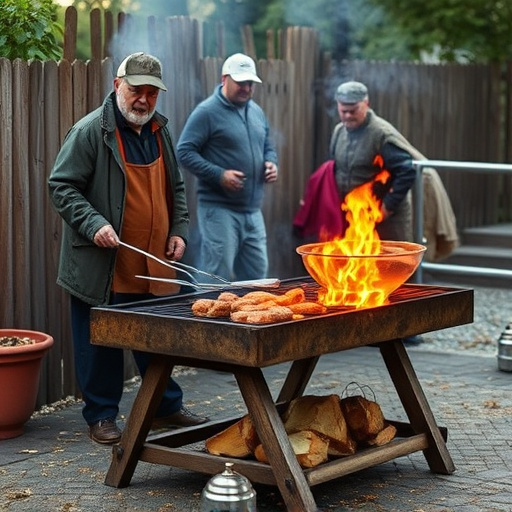
When serving your mouthwatering barbecue ribs, think beyond just a delicious main course. Ribs are a versatile centerpiece that can elevate any meal into an unforgettable culinary experience. For a classic pairing, grill some corn on the cob alongside your ribs—the sweet flavor of summer corn complements the smoky, tangy rib sauce perfectly. Round out the meal with coleslaw, offering a crisp contrast to the tender ribs.
Don’t be afraid to experiment with side dishes that complement the rich, savory flavors of your bbq rib recipe. Baked beans, grilled vegetables, or even a simple green salad can all work beautifully alongside these classic barbecue favorites, ensuring every bite is a delightful blend of textures and tastes.
